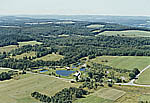
|
Most types of ponds will support a bass population as long as a few simple rules are observed.
Bass should be stocked at a rate of 75-100 fish per acre along with a forage fish. We recommend fathead minnows and/or crayfish. The minnows should be stocked at a rate of no less than 1000 per acre and a rate of 5000-10,000 per acre is ideal. The crayfish should be stocked at a rate of at least 400-500 per acre. These numbers should be increased if there is already an established bass population in the pond. With the exception of black crappie we do not recommend sunfish, such as bluegill, as a forage fish in northern regions. Because of the short growing season for bass in the north they are not able to keep up with much more prolific sunfish. Eventually the sunfish will take over the pond without intense management. Crappie do not spawn as prolifically as other sunfish so therefore it's easier for the bass to keep their numbers in check. Yellow perch may be another option as a second forage fish although they have been known to take over a pond now and again. Crappies and/or perch are a great option if you enjoy ice fishing.
A bass requires 8 lb. of live food to gain 1 lb. of body weight. Therefore, we emphasize the importance of a good forage fish population. When stocking a bass pond with a forage fish it is EXTREMELY important that they have cover to breed and hide in, such as grass, cattails, weeds, etc. It is so important, in fact, that a substantial portion of your pond should be dedicated to forage fish cover and reproduction. If your pond is clean some thought should be given to providing some type of artificial cover. Brush, old Christmas trees, or piles of flat rocks all work well. We recommend 50-100 old Christmas trees per acre. Often times tree farms need to cull out inferior trees and you may be able to get them cheap or even free if you are willing to take them off their hands. Cover for the forage fish should be concentrated in the shallower areas of your pond, no deeper than 4 or 5 feet of water. The more emphasis you put on cover for your forage fish the better balanced your pond will be. If your pond water is clear this is an indication that there is little photoplankton and zooplankton for the forage fish to feed on. This being the case you should fertilize the pond. There are several different organic materials which can be used. Some examples are hay, soybean meal, distillers, and cow, horse or sheep manure. Recommended quantities per acre are: 200lbs. of hay; 100 lbs. of soybean or distillers; or 300 lbs. of manure.
Example of a rock pile used for forage fish.
Largemouth bass do not naturally take a commercial fish pellet, however, all of the largemouth bass that you purchase from us are trained to feed on a pellet. Therefore, if you would like to augment there diet this way you will get increased growth and your forage base will last longer. You could choose to do this by either hand feeding or with an automatic fish feeder. Pound for pound pellet feeding is the cheapest growth you can get on your fish. We do not suggest relying solely on pellet feeding, however, as you will not be able to feed them during the winter months and once they spawn the babies will not take a commercial feed.
Attention needs to be paid to bass habitat as well. They need to have places to hide and feel secure just like the forage fish. Bass like to hang out around larger structures in the deeper sections of your pond. Piles of logs, rock piles and piles of old tires all work well but almost anything can be used. Structure could be built out of PVC pipe or old scrap metal welded together, even old car frames. You don't need to spend a lot of money just use your imagination.
Largemouth and smallmouth do not cohabitate well so different factors should be considered when deciding which is best for your situation. Smallmouth bass do better in cooler and deeper ponds and are much more active in cooler water so they can be fished through the ice. They do not reproduce as quickly as largemouth, therefore, if the pond is not going to be fished heavily smallmouth may be a good choice. Also, if other fish are going to be introduced into the pond, then a smaller fish can be stocked as smallmouth do not grow quite as large as a largemouth and have a smaller mouth, thus cutting down on predation.
Once bass and forage fish have been established in a pond little additional stocking should be required, other than additional fathead minnows occasionally. Heavy fishing will not hurt, in fact, once a bass pond is established fishing is your best management tool but no fishing should be done while the fish are on their spawning beds. For smallmouth this is usually from May 1-May 20 (depending on water temp., which needs to be 60 degrees) and for largemouth, from May 20-June 15 (water temp. at 65 degrees).
If you're looking for another fish to stock with your bass we highly recommend channel catfish. They don't really compete with the bass, grow very large, are fun to catch and are really good to eat. For more information see our "Catfish Information" page.
Care should be taken when purchasing bass as they are a regional fish. Bass from warmer climates will not do well in NYS waters and will be stunted. Be sure your fingerlings are of northern brood stock. If you have any questions feel free to call us days or evenings.
|
|






